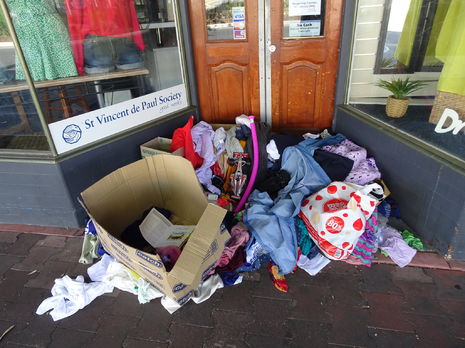Buying secondhand won’t solve the sustainability crisis
Elsie McDowell argues that we need a complete overhaul of how we view our clothing

By now, most people are aware of the issues with fast fashion. Companies like Shein or H&M pump out an unfathomable amount of clothes, produced by exploited, often child, workers. Ultimately, all these clothes end up sitting in landfills where they inevitably get thrown away due to their poor quality or because the incessant pull of consumerism leads us to replace items that are still functional. As a result of increasing awareness of these issues, secondhand fashion is on the rise. Over the course of a decade, telling someone that a jumper was from a charity shop has gone from something that you would have been mocked for in school to something to be proud of.
So, secondhand clothes: the perfect solution. Right? The key benefit of buying clothes secondhand is that it extends the time before they wear out completely, and, at least in the UK, charity shops help support charities like Cancer Research or Crisis. However, secondhand clothing is just a sticking plaster solution. Secondhand clothing relies on a stream of fast fashion clothing coming into charity shops and apps like Vinted or Depop, which even if you are not buying them from the source, are still poor quality and will quickly wear out, especially if they were already heavily used.
Perhaps if the clothes coming into charity shops were of higher quality to start with, shopping secondhand could be an important part of a more circular economy. However, currently only 10-30% of donated clothes are ever sold. Our rejected secondhand clothes are then often sent to the Global South, producing tonnes upon tonnes of carbon in the process. Furthemore, the global trade of secondhand clothes has killed many local textile industries, especially in Ghana. The sheer volume of secondhand clothes going through this cycle is easy to underestimate, 15 million items of used clothing move through one market in Accra, Ghana’s capital, every week. We currently have enough clothing on the planet to clothe six generations of people, so most of these secondhand clothes are still going to landfill, just through a more convoluted, carbon-intensive route.
“We currently have enough clothing on the planet to clothe six generations of people”
When we donate a large portion of our fast fashion purchases, we think of ourselves as “good” consumers. But being lulled into this false sense of sustainability can just lead us to justify consuming more. Increasingly people are just moving their fast fashion over-consumerism onto secondhand fashion. I am definitely guilty of this; I could scroll on Vinted for hours and buy yet another top because, well, it’s only £3. And whilst it is arguably better that we do this with secondhand clothes rather than fast fashion, in the long term this is not going to tackle the overproduction of cheap clothes. We may even have more of a throw-away attitude towards second clothes, because they are cheaper and of less value to us, so we buy yet more clothes we don’t need just to end up re-donating or throwing them away.
So, where do we go from here? The average person in the UK buys 60% more clothing today than 20 years ago, so at the heart of the problem is simply buying less clothes. Currently, our clothes are of such poor quality that it is difficult to learn to mend or upcycle them, although this is still an important part of making our clothing last longer. Whilst undoubtedly we need a systematic change in the way our clothes are produced, on an individual level we also need to start seeing our clothes as a reflection of the work that goes into them.
“We need to start seeing our clothes as a reflection of the work that goes into them”
To buy a top for £3 on Shein, someone needs to have been paid less than that to make it; Shein’s garment workers are paid as little as 3p per item they produce. Almost all clothing is handmade in some form; we just don’t think of it as such because the hands making our clothes are on the other side of the world in crowded factories working 18 hour days. This is hardly what we associate with the word ‘handmade’. It is a difficult pill to swallow to say that our clothes need to be more expensive, but there is no other way around this. The clothes we buy need to become an investment again.
Ultimately, I am not trying to say that we should all stop buying clothes secondhand. However, the way we currently buy our clothes secondhand is not the long-term solution to the unethical and unsustainable production of clothing. As long as the fast fashion model exists, it will continue to rely on environmental degradation and worker exploitation. Secondhand fashion needs a change at its source. Once the first-hand clothes we buy are produced by people being paid a fair wage, in a more sustainable manner, and then bought in lower quantities, shopping secondhand can become an important part of extending the life cycle of our clothes until they are recycled. Only when we are willing to let go of Primark prices and view clothes as worthwhile investments can we begin to tackle the constant cycle of overproduction and overconsumption that fast fashion epitomises.
 News / Cambridge students set up encampment calling for Israel divestment6 May 2024
News / Cambridge students set up encampment calling for Israel divestment6 May 2024 News / Cambridge postgrad re-elected as City councillor4 May 2024
News / Cambridge postgrad re-elected as City councillor4 May 2024 News / Some supervisors’ effective pay rate £3 below living wage, new report finds5 May 2024
News / Some supervisors’ effective pay rate £3 below living wage, new report finds5 May 2024 Fashion / Class and closeted identities: how do fits fit into our cultures?6 May 2024
Fashion / Class and closeted identities: how do fits fit into our cultures?6 May 2024 Features / Cambridge punters: historians, entertainers or artistes? 7 May 2024
Features / Cambridge punters: historians, entertainers or artistes? 7 May 2024






